Today, there are two pretty popular interior design styles that seem to be at complete opposite ends of the interior design spectrum: minimalist and eclectic. Whether you’ve just bought a home, you’re looking to do a home renovation or you’re just curious which style suits you, it is important to know the essential features of a minimalist design and an eclectic design.But, how do you know which one is right?
There are three essential features of both the minimalist style and the eclectic style: knowing these features will help you determine which one is right for you. While interior design blogs, magazines and websites put forth a seemingly endless number of tips, tricks and examples of both minimalist interior design and eclectic interior design, the overwhelming amount of information can leave you feeling more confused than before! How can you know which interior design style is the right one for you, your family and your home if you can’t determine the essential essence of each style?
With the help of professionals at Freshome, we’ve boiled down the two interior design styles to their essential features to help you know which interior design style (minimalist or eclectic) is right for you! Keep reading to learn what is eclectic style as well as how to decorate minimalist style.
Minimalist Interior Design: What Is Minimal Style?
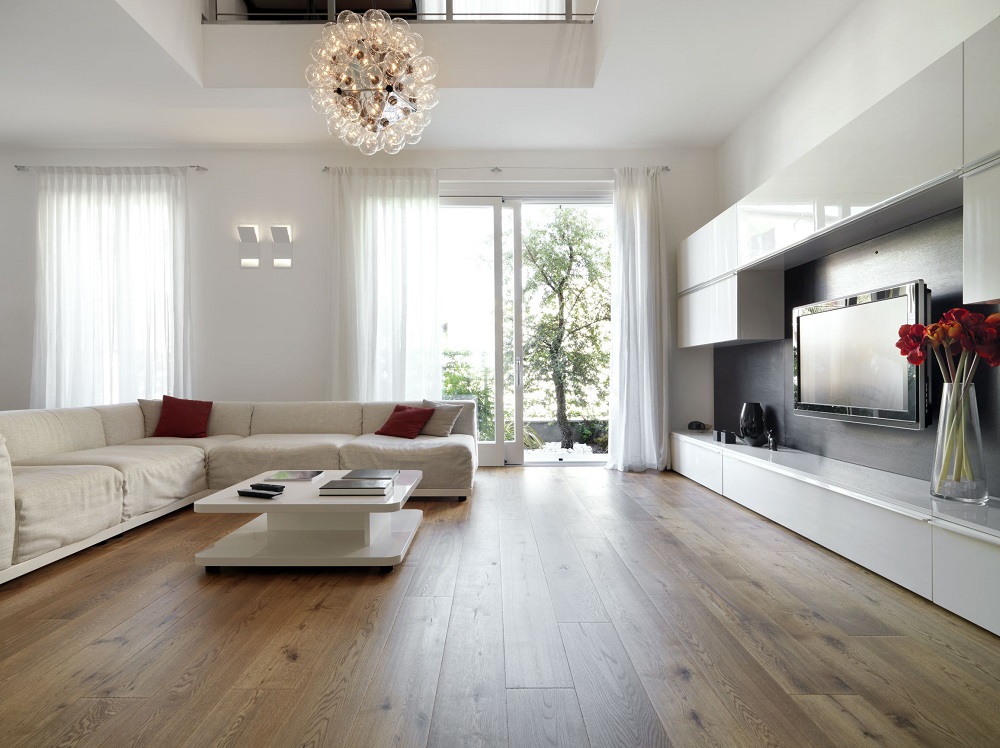
Minimalist Interior Design
A minimalist interior design style can seem, at first glance, to be stark, bare, cold, boring or even depressing. After all, shouldn’t our interior design be about personalization and uniqueness, not blandness, sameness and monotony? However, this understanding of minimalist style doesn’t address the ultimate purpose of the minimalist decor.
So, what is minimalist style?
A minimalist house is not just a plain, white box, but is, rather, a place of refuge from clutter and excess. In a sentence, the minimalist style is one that emphasizes simplification, simplicity and function. When it comes to minimalist interior design, the overall style prefers only what is absolutely necessary and design elements that have a specific purpose or reason.
The appeal of a minimalist home has been studied by researchers, who’ve concluded that interiors that emphasize function and eliminate excess are better for your mental, physical and emotional health.
But how to decorate minimalist style?
If you like the concept behind the minimalist style, but are not sure how to decorate minimalist style, we’ve gathered the top three essential features of a minimalist home to help guide you in your interior design projects.
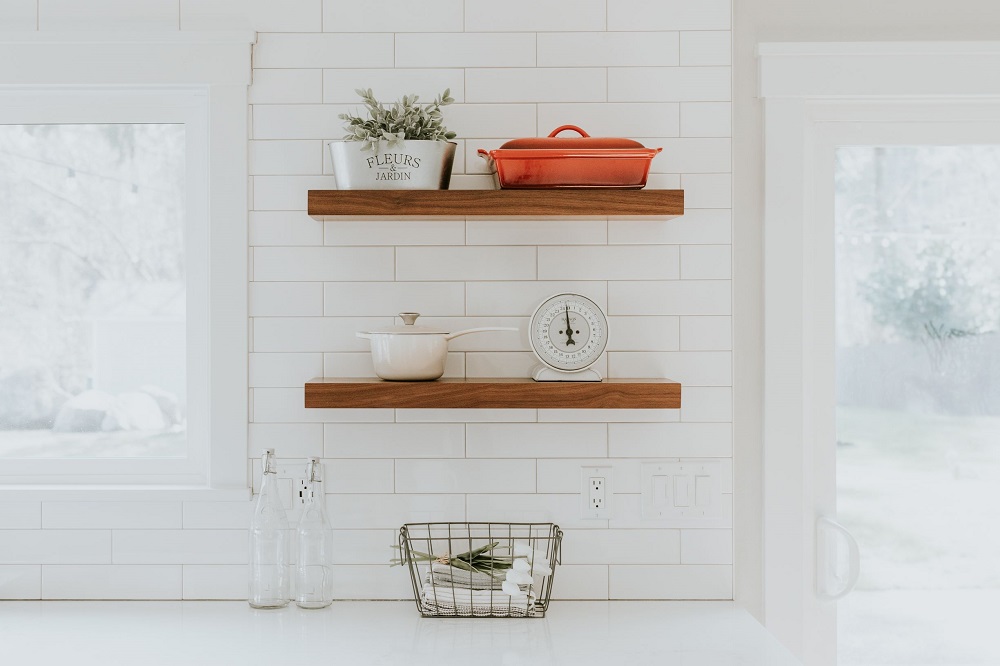
Minimalist Interior
#1 Focus on Function & Eliminate Excess
The hallmark of a minimalist home, a minimalist house or minimalist decor is function. Functional design elements can double as a storage space and an art piece or focal point. When you declutter your home and eliminate extraneous design elements, you allow the focus to remain with the room’s primary purpose and function.
Excessive wall art, decor accessories, rugs, blankets or pillows do not necessarily enhance the functional element of the space. In fact, items such as these detract from a room’s purpose and function (when used in excess) and should be removed. Instead, consider items that are both artistic and simultaneously fulfills a purpose: a unique light fixture or a brightly-colored furniture item.
#2 Make Empty Space Interesting
Empty space is the second hallmark of a minimalist interior design style. Clean walls, free corners or unoccupied areas in a room are essential to a minimalist house, contributing to the overall feel of lightness. Keep in mind that empty does not mean boring or bland: an empty wall can be filled with a unique wallpaper design, pattern or material (such as brick), while an empty space on the floor can highlight the gorgeous wood flooring.
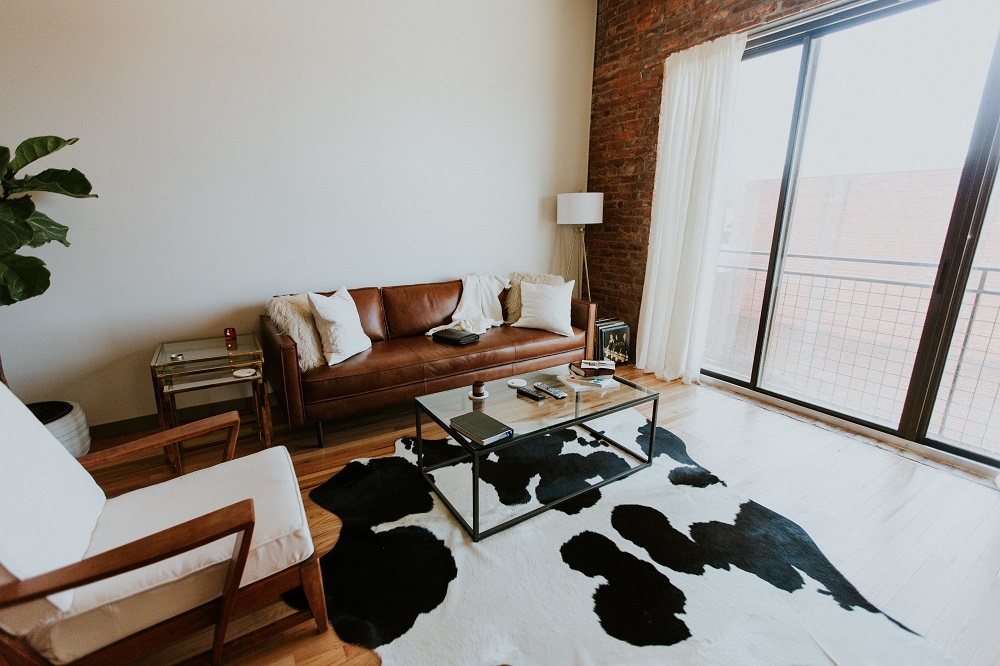
Flooring
#3 Color, Texture & Patterns In Moderation
A common misconception with the minimalist interior design style is that you should stray away from use of color, textures or patterns. However, this is not the case. The lack of clutter and excess in a minimalist house means that the colors, designs, textures and patterns that you do use play a much larger part in the overall design than they would in an eclectic design, for instance (e.g. consider the image above and the use of the textured rug).
Without excessive ornamentation, you can get bold and creative with your color scheme, if desired. For the few furniture items that you have in your minimalist house, don’t be afraid to incorporate texture, so long as the piece is also functional. The less you have means that what you do have will stand out, so incorporate color, texture and pattern into these minimalist decor items.
Eclectic Interior Design: What Does Eclectic Mean?
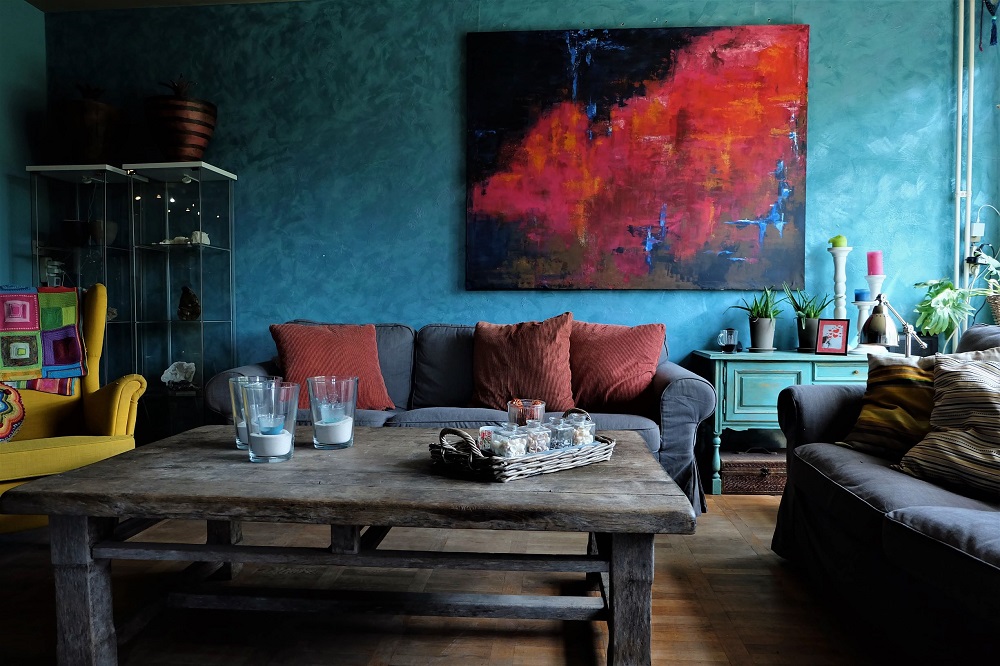
Eclectic Interior Design
At first glance, eclectic interior design may seem like a hodge-podge of items, designs, textures, patterns, colors and styles all thrown into the same room. Sure, to the untrained eye, eclectic style is a mess and it is hard to know how to throw different elements together in a way that still looks like everything goes together. How can you ensure that the design fits, that there is flow and consistency despite mixing and matching, or that everything looks intentional rather than haphazard and cluttered? First, it might serve us to know the definition of “eclectic.”
So, what does eclectic mean?
The dictionary defines “eclectic” as selecting and using what are considered the best of all systems and sources. When it comes to interior design, eclectic style is all about harmony of disparate elements (e.g. contrasting colors, juxtaposing textures and distinct styles) to create a cohesive space. Thus, eclectic style is a hodge-podge of various design elements, but it is unified in a few key ways.
If the thought of throwing together a vibrant mix of eclectic furnishings and elements is intimidating, this doesn’t necessarily mean the eclectic interior design style isn’t for you. All you really need to know to master the eclectic style is how to keep your space from looking cluttered and inconsistent and how to create a sense of unity despite overwhelming difference. We’ve gathered the top three essential features of the eclectic interior design style to guide you in your interior design home renovation endeavors.
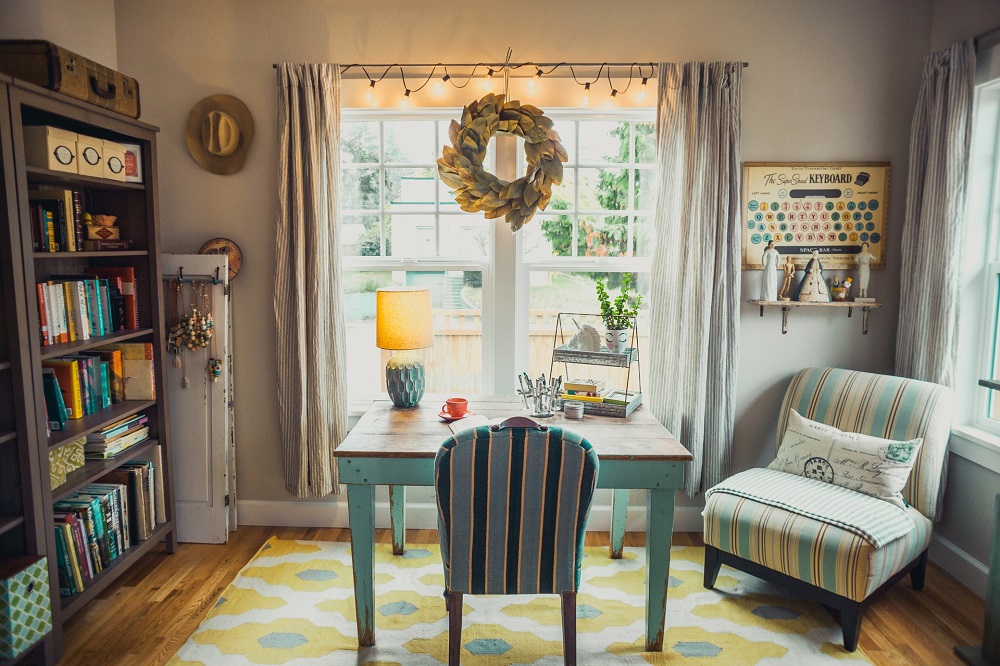
Eclectic Interior
#1 Celebrate Difference & Contrast, But Don’t Be Inconsistent
The primary hallmark of the eclectic home is mixing and matching styles, patterns, colors, textures to create contrast: contrast and difference is at the heart of the eclectic style. If you choose a simple color palette, consider incorporating both smooth and rough textures, such as marble countertops, smooth leather sofas, metal wall art, wood mantels, woven rugs, stone walls, fluffy throws or brick fireplaces.
In addition to the liberal use of different and contrasting textures, apply the same logic to home decor items and furniture styles, patterns and wall decor. For instance, incorporate furniture pieces from different design eras (e.g. combine modern with Art Deco, or rustic with vintage).
Additionally, use patterned rugs, geometric shapes and polka dots in combination to create aesthetic intrigue. When seemingly opposing patterns are used in conjunction, visual intrigue is created, as well as a fun and whimsical atmosphere. Lastly, incorporate a gallery wall design in your eclectic living room: there is no space better designed to suit the mix and match aesthetic of a gallery wall than an eclectic living room.
Wondering how to avoid being inconsistent in eclectic style?
True, the nature of the eclectic design is to be varied, but the overall style you create can be carried consistently throughout the home. If the style changes abruptly from room to room, the overall flow is disjointed and the eclecticism of your home will not have been truly realized.
#2 Unity & Color Coordination
The secondary hallmark of the eclectic style is coordination and unity: the eclectic style is not about actively disrupting coordination, but about establishing a consistent theme as the background upon which the disparate elements can coexist. To create a successful eclectic interior design, it is critical to maintain a common thread or unifying factor throughout the space.
How do you maintain a common thread?
Oftentimes, in eclectic interior designs, color is used as that unifying factor, or common thread. If possible, try to find eclectic decor items that match the color on your walls. Alternatively, find eclectic decor items that match each other in color and complement the wall color (as shown in the image above). This will help you to stay true to your eclectic design, while avoiding disjointedness and creating a subtle sense of unity throughout the space.

Eclectic Style
#3 Furniture Layout & Empty Space
The strategic use of empty space within the overall layout of furniture and decor items is the third hallmark of the eclectic interior design style. The eclectic design would not work without the strategic use of empty space. In any true eclectic design, you will see a space of absence, where the eclectic decor or eclectic furniture are not. Eclectic does not mean filled to the brim and bursting at the seams, but, rather, a collection of elements, each of which were previously considered to be of a distinct style. This hodge-podge of items is maintained by the strategic use of negative space.
How does this work?
When creating an eclectic design, keep in mind that your eyes need to have a space to rest: leave space on a shelf, keep your coffee table completely empty or designate a portion of wall to the absence of art.
It is easy to get caught up in displaying all the disparate elements of various textures, patterns and colors when planning an eclectic home. However, keep in mind that your eclectic design can be elevated by focusing first on layout. Placement and layout of furniture is more important than the objects within a room, since the layout is what will make it feel comfortable or not. Once you find the best furniture layout, it will be easier to leave out a few items, allowing the negative resting space to keep your eclecticism in balance.
Minimalist Interior Design VS Eclectic Interior Design
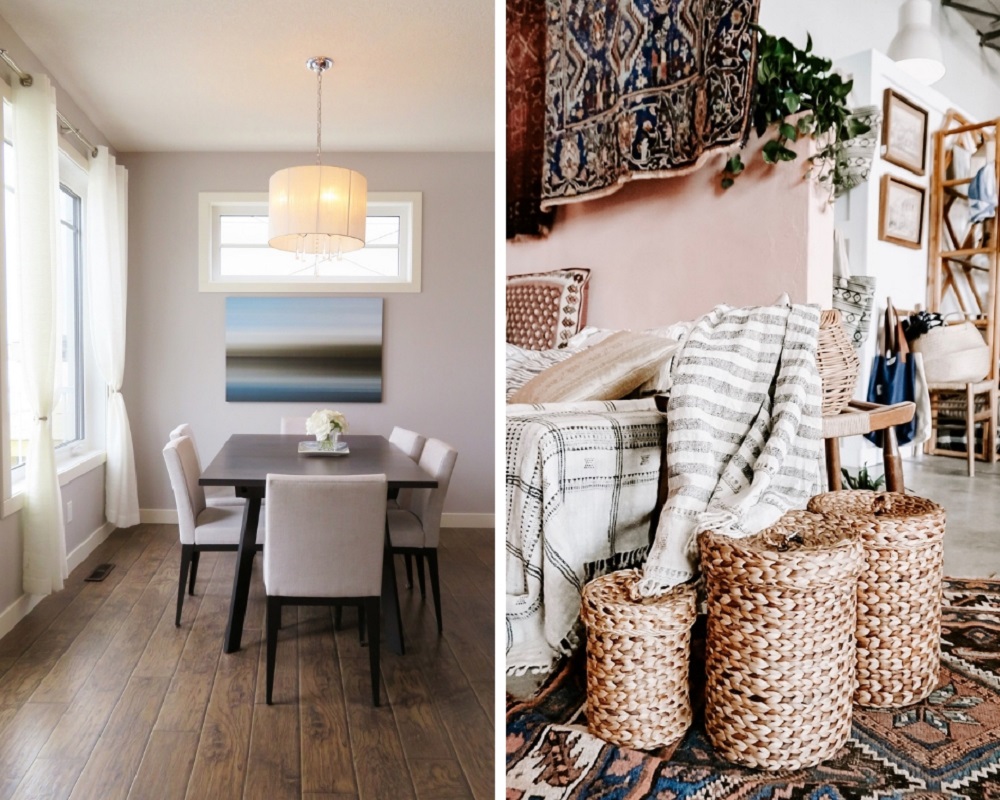
Minimalist Style vs Eclectic Style
When it comes to deciding on the interior design style for your home, how do you know whether you should go for a minimalist interior design style or an eclectic interior design style? Your interior design style really just boils down to what comes naturally to you: does a minimalist house feel bare and uninviting or functional and useful? Does an eclectic home feel overwhelming and cluttered or personable and unique?
Deciding on an interior design style for your home can be tricky, but hopefully you’ve got a good idea now of the hallmarks of minimalism and eclecticism to know which one is right for you.
This post was written by Kara Roberts, blogger and content writer for Canvas Vows. We specialize in creating custom made canvas prints and have been featured in a number of publications, including Brides. For more interior design tips, gift ideas, anniversary celebrations, and personalized canvas creations check out our blog!






